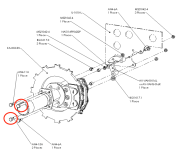I'm currently working on bolting my Beringer brake calipers onto the main wheel fairing brackets for my RV-10. All 5 bolts provided by Beringer seem to be too short because the shank does not extend all the way through the parts. For some of the bolts (maybe all of them) I could go up to the next length bolt and the shank would just barely make it to the other side of the parts. I'd like to think that Beringer wouldn't get this wrong and I can't find any other posts about it so I figured I would check if this is actually ok.
AC 43.13 says:
But "in general" doesn't necessarily mean always, so does the shank need to extend all the way through all of the parts being bolted together or is it ok if only threads are visible exiting the hole as long as there are enough threads for the nut?
AC 43.13 says:
In general, bolt grip lengths of a fastener is the thickness of the material the fastener is designed to hold when two or more parts are being assembled
But "in general" doesn't necessarily mean always, so does the shank need to extend all the way through all of the parts being bolted together or is it ok if only threads are visible exiting the hole as long as there are enough threads for the nut?





